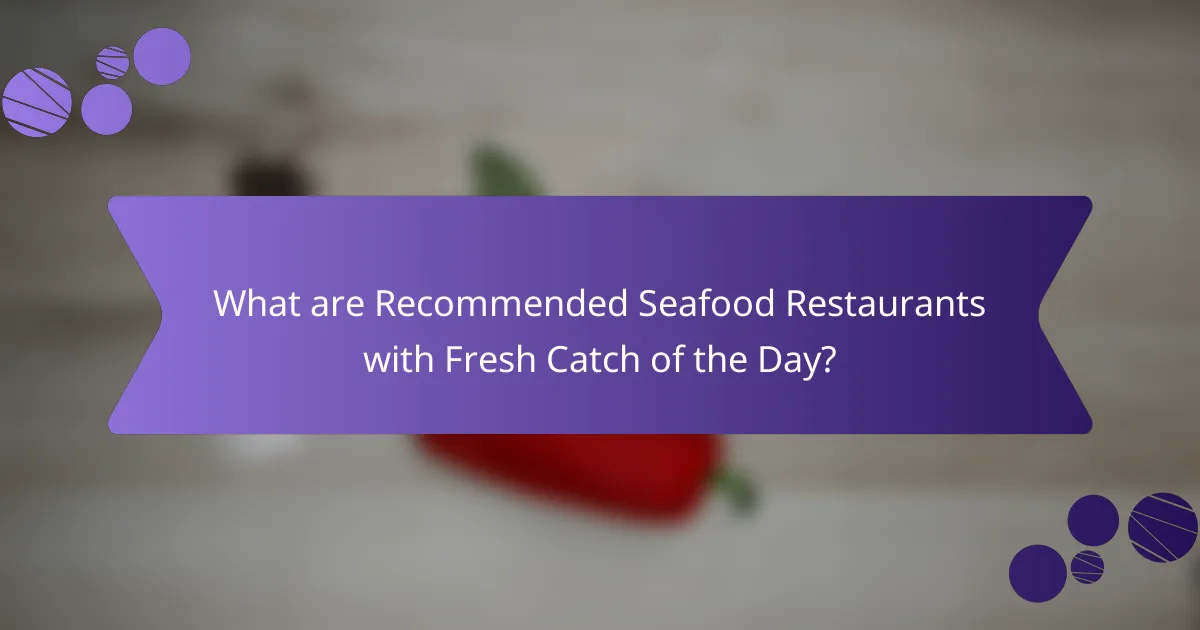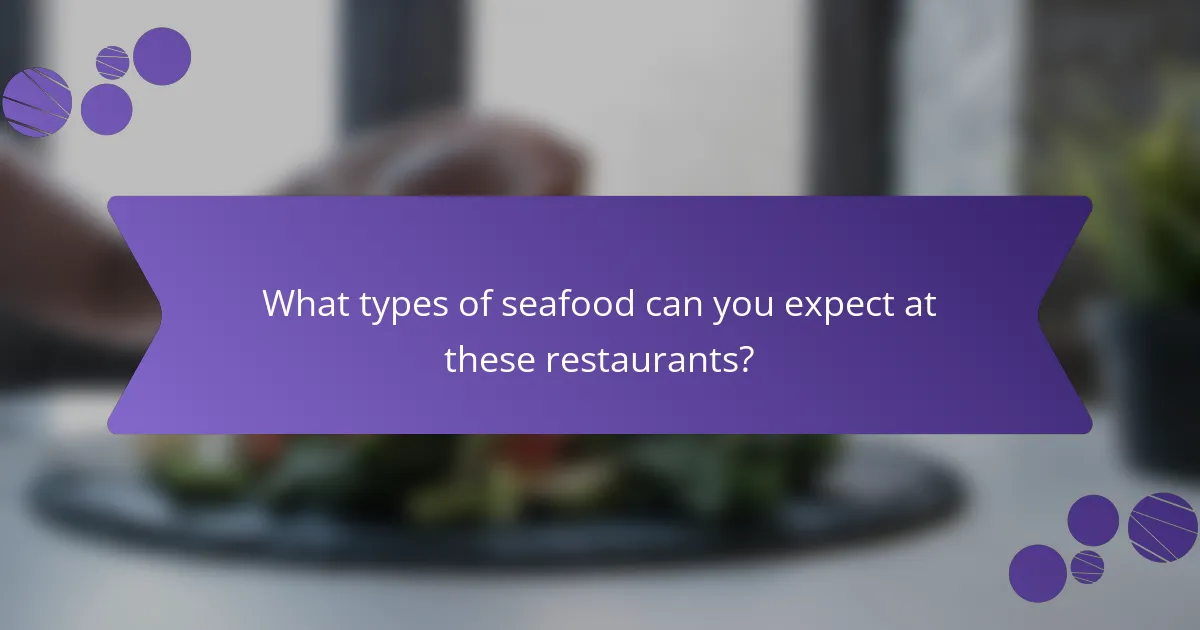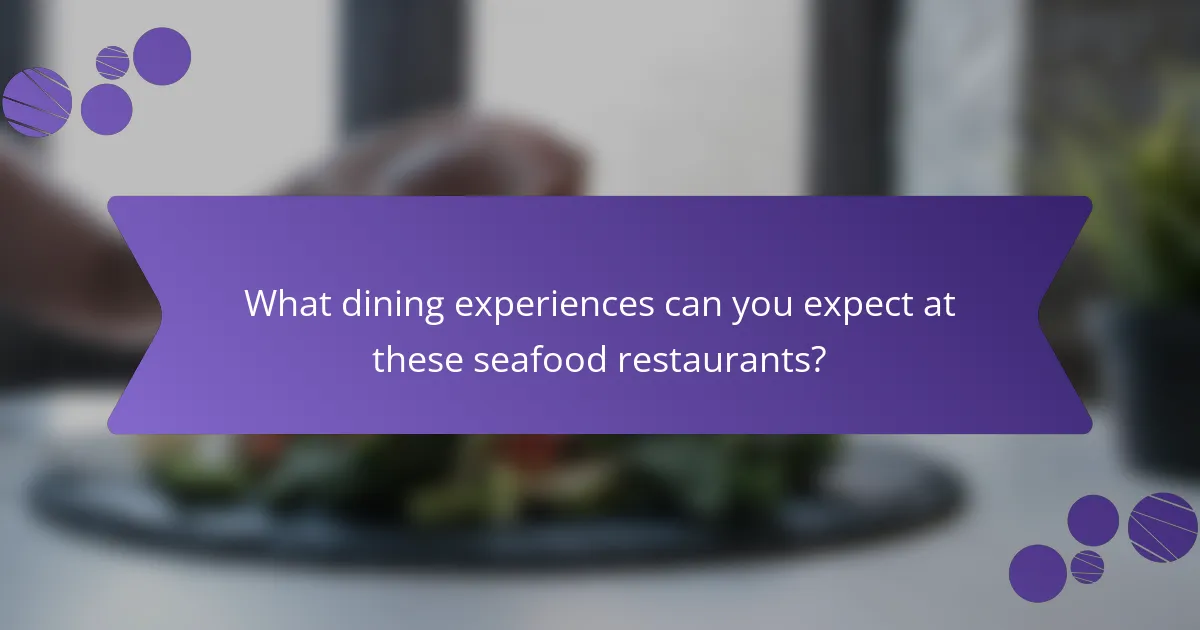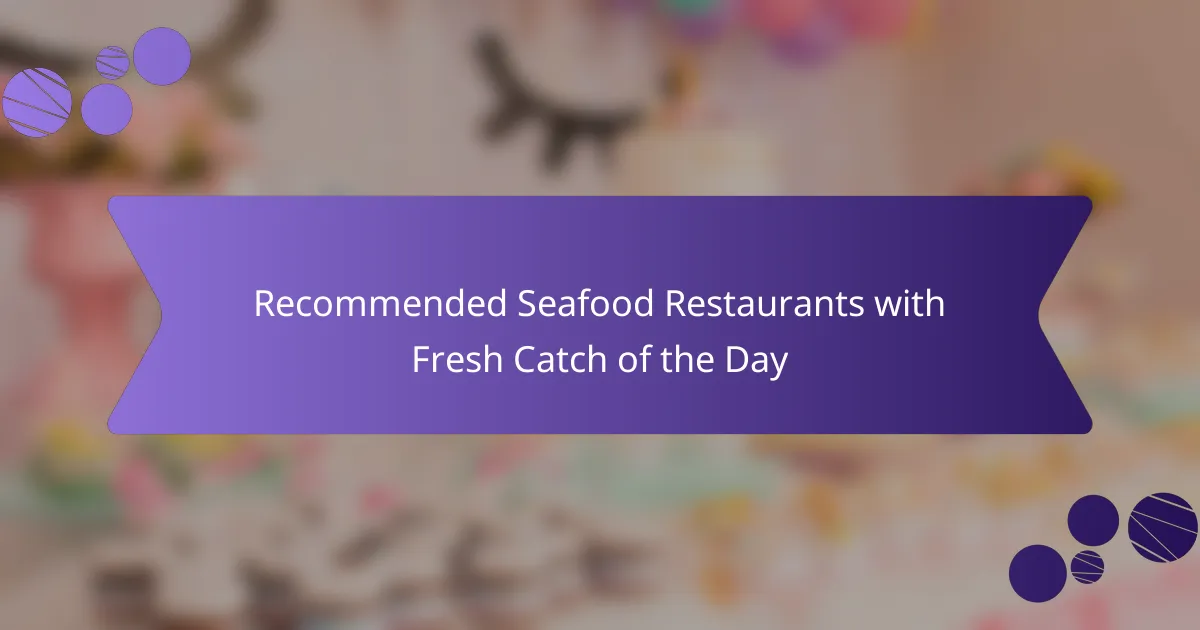
What are Recommended Seafood Restaurants with Fresh Catch of the Day?
Recommended seafood restaurants with fresh catch of the day include The Crab Shack, known for its daily seafood specials. Another option is Joe’s Seafood, which sources fish directly from local fishermen. The Oyster Bar offers a rotating menu based on daily catches. Each restaurant emphasizes freshness and quality. Many customers report high satisfaction with the seafood’s taste and presentation. These establishments often feature seasonal seafood options. They provide a unique dining experience with local flavors.
How do these restaurants ensure the freshness of their seafood?
Restaurants ensure the freshness of their seafood through several key practices. They source seafood directly from local fishermen or reputable suppliers. This reduces the time from ocean to plate. Many restaurants also prioritize seasonal catches. This ensures availability of the freshest options. They often display ice beds to keep seafood at optimal temperatures. Regular inspections of seafood quality are conducted upon delivery. Staff are trained to recognize signs of freshness, such as smell and appearance. Additionally, some restaurants implement traceability systems to monitor seafood origins. These practices collectively guarantee that the seafood served is fresh and safe for consumption.
What sourcing practices do these restaurants use for their catch of the day?
Restaurants often utilize sustainable sourcing practices for their catch of the day. They frequently partner with local fishermen to ensure freshness and reduce transportation time. Many establishments prioritize seafood certified by organizations like the Marine Stewardship Council. This certification indicates adherence to sustainable fishing practices. Additionally, restaurants may participate in community-supported fisheries. This model allows consumers to receive regular, fresh seafood directly from local sources. Some restaurants also track seasonal availability to offer the freshest options. By implementing these practices, they contribute to responsible seafood consumption.
How do seasonal changes affect the availability of fresh seafood?
Seasonal changes significantly impact the availability of fresh seafood. Different species of fish and shellfish have specific breeding and migration patterns that align with the seasons. For example, many fish spawn in warmer months, leading to increased availability during summer. Conversely, colder months often see a decline in certain species due to migration to deeper waters.
Additionally, weather conditions can affect fishing activities. Storms and rough seas may limit fishing opportunities, reducing the catch. Furthermore, some seafood is only available during specific seasons due to regulations aimed at sustainability. For instance, certain species may have closed seasons to protect their populations.
Overall, the interplay between seasonal cycles and fishing practices dictates the variety and quantity of fresh seafood available at any given time.
Why should you choose seafood restaurants that offer a fresh catch of the day?
Choosing seafood restaurants that offer a fresh catch of the day ensures higher quality and flavor. Fresh seafood is often more nutritious, retaining essential vitamins and minerals. It typically has a better texture and taste compared to frozen or previously stored options. Many seafood restaurants source their catch directly from local fisheries, promoting sustainability. This practice supports local economies and reduces carbon footprints associated with transportation. Studies show that fresh seafood can be safer, with lower risks of spoilage and contamination. Additionally, dining on fresh catch can enhance your culinary experience, as chefs often prepare seasonal dishes that highlight the day’s selection.
What are the health benefits of consuming fresh seafood?
Consuming fresh seafood offers numerous health benefits. It is rich in omega-3 fatty acids, which support heart health. Omega-3s can lower blood pressure and reduce the risk of heart disease. Fresh seafood is also a great source of high-quality protein, essential for muscle growth and repair. Additionally, it contains vital nutrients like vitamin D and selenium. These nutrients play a role in bone health and immune function. Research indicates that regular seafood consumption may improve cognitive function and reduce the risk of mental decline. The American Heart Association recommends eating fish at least twice a week for optimal health.
How does fresh seafood compare to frozen alternatives in terms of taste and quality?
Fresh seafood generally offers superior taste and quality compared to frozen alternatives. The freshness of seafood enhances its flavor profile and texture. Fresh seafood typically has a more delicate and nuanced taste. It also retains a firmer texture, which is often preferred by consumers. In contrast, frozen seafood may undergo changes during freezing that can affect taste and texture. Studies indicate that freezing can lead to moisture loss, impacting the overall quality. Additionally, fresh seafood is often sourced locally, ensuring optimal freshness. This local sourcing can enhance the flavor, as seafood is consumed shortly after being caught.

What types of seafood can you expect at these restaurants?
At these restaurants, you can expect a variety of seafood options. Common types include fish, shellfish, and crustaceans. Popular fish varieties are salmon, tuna, and cod. Shellfish options often include shrimp, scallops, and clams. Crustaceans like lobster and crab are frequently featured. Some restaurants may also serve regional specialties. Fresh catch of the day is typically highlighted on the menu. Seasonal availability affects the types of seafood offered.
What are the most common types of fish served as the catch of the day?
The most common types of fish served as the catch of the day include cod, halibut, and salmon. Cod is popular due to its mild flavor and flaky texture. Halibut is favored for its firm meat and versatility in cooking. Salmon is well-known for its rich taste and health benefits. Other frequently served fish may include mahi-mahi, snapper, and trout. These fish are often sourced locally, ensuring freshness. Seasonal availability can affect which types are offered. Many restaurants highlight these options on their menus to attract customers.
What unique or rare seafood options might be available?
Unique seafood options include geoduck, monkfish, and sea urchin. Geoduck is a large clam known for its sweet flavor and unique texture. Monkfish, often referred to as “poor man’s lobster,” has a firm, meaty texture and mild taste. Sea urchin, or uni, is prized for its creamy, rich flavor and is often served raw. These seafood varieties are not commonly found in standard markets. They are typically available at specialty seafood restaurants that focus on fresh and unique catches. Each of these options offers distinct culinary experiences that are celebrated in various cuisines.
How do different cooking methods enhance the flavors of various seafood types?
Different cooking methods enhance the flavors of various seafood types by altering their texture and releasing natural oils. Grilling seafood caramelizes the exterior, creating a smoky flavor. Steaming retains moisture and highlights the seafood’s natural taste. Sautéing with butter adds richness and depth. Baking allows for even cooking while infusing flavors from herbs and spices. Poaching gently cooks seafood, preserving its delicate flavor and texture. Frying creates a crispy exterior, contrasting with tender flesh. Each method interacts uniquely with different seafood types, enhancing their distinct characteristics. For example, fatty fish like salmon benefit from grilling, while shellfish like shrimp shine when sautéed.
How can you find the best seafood restaurants with a fresh catch of the day?
To find the best seafood restaurants with a fresh catch of the day, start by researching online reviews. Websites like Yelp and TripAdvisor provide user-generated ratings and comments. Look for restaurants that highlight their daily catch in their menus or promotions. Visiting local seafood markets can also lead you to nearby restaurants known for fresh seafood. Additionally, asking locals for recommendations can yield valuable insights. Many top seafood restaurants source directly from fishermen, ensuring freshness. Checking social media platforms can reveal real-time updates on daily specials. Always consider the restaurant’s location near the coast for better access to fresh seafood.
What online resources or apps can help you discover local seafood restaurants?
Online resources and apps that help discover local seafood restaurants include Yelp, Google Maps, and TripAdvisor. Yelp provides user reviews and ratings, making it easier to find popular seafood spots. Google Maps offers location-based searches and user-generated photos. TripAdvisor features detailed reviews and rankings of seafood restaurants. Other useful apps include Zomato, which specializes in restaurant discovery, and OpenTable for reservations. These platforms aggregate user experiences and provide valuable insights into local seafood dining options.
How do customer reviews influence your choice of seafood restaurant?
Customer reviews significantly influence the choice of seafood restaurant. Positive reviews often highlight freshness and quality of the seafood. They provide insights into the dining experience, including service and ambiance. Many customers rely on ratings and comments to gauge the restaurant’s reputation. Research indicates that 84% of people trust online reviews as much as personal recommendations. Negative reviews can deter potential customers, impacting the restaurant’s foot traffic. Overall, customer feedback shapes perceptions and decisions regarding seafood dining options.

What dining experiences can you expect at these seafood restaurants?
Seafood restaurants offer unique dining experiences centered around fresh and high-quality seafood. Patrons can expect a variety of dishes featuring local catches, often prepared with seasonal ingredients. Many seafood restaurants emphasize sustainable sourcing, ensuring the seafood is fresh and environmentally friendly. Diners may enjoy interactive experiences, such as seafood boils or raw bars, where they can select items directly. The ambiance often reflects coastal themes, enhancing the overall dining experience. Additionally, many establishments provide pairings with wines or craft beers that complement seafood flavors. Seasonal specials frequently highlight unique preparations or rare catches, making each visit distinct. Overall, seafood restaurants create an engaging culinary atmosphere focused on freshness and flavor.
How do ambiance and service contribute to your dining experience?
Ambiance and service significantly enhance the dining experience. Ambiance includes factors like lighting, decor, and music. A well-designed ambiance creates a welcoming atmosphere. Studies show that pleasant surroundings can increase customer satisfaction by up to 30%. Service quality impacts how guests perceive their meal. Attentive and friendly staff can elevate the overall experience. Research indicates that excellent service can lead to repeat visits and positive reviews. Together, ambiance and service create a memorable dining experience that encourages customers to return.
What are some common themes or styles in seafood restaurant decor?
Common themes in seafood restaurant decor include nautical elements, coastal colors, and rustic materials. Nautical elements often feature items like fishing nets, ropes, and anchors. Coastal colors typically consist of blues, greens, and sandy neutrals. Rustic materials may include reclaimed wood and metal accents. Many seafood restaurants also incorporate marine life artwork or murals. These decor choices create an inviting and thematic dining experience. The design aims to reflect the oceanic origins of the menu items. This thematic approach enhances the overall ambiance and customer enjoyment.
How does the staff’s knowledge about the menu enhance your meal?
The staff’s knowledge about the menu enhances your meal by providing tailored recommendations. Their expertise allows them to suggest dishes that match your taste preferences. Knowledgeable staff can highlight the freshest seafood options available. They can explain preparation methods and ingredient sourcing. This insight helps diners make informed choices. It also enhances the overall dining experience. Engaging with knowledgeable staff can lead to discovering new flavors. Research shows that informed service can increase customer satisfaction significantly.
What are some tips for ordering seafood at a restaurant?
When ordering seafood at a restaurant, prioritize freshness. Ask the server about the catch of the day. Fresh seafood is typically more flavorful and safe to eat. Inquire about how the seafood is sourced. Sustainable practices ensure better quality. Pay attention to seasonal offerings. Certain seafood is best during specific times of the year.
Request recommendations from the staff. They often know the best dishes. Consider the preparation method. Grilled or steamed options usually retain more flavor. Avoid seafood that has a strong fishy smell. Fresh seafood should have a mild scent. Lastly, check for any specials. Restaurants often highlight fresh and local options.
How can you ask about the freshness and sourcing of the catch of the day?
You can ask about the freshness and sourcing of the catch of the day by directly inquiring with the server. Ask, “Where is today’s catch sourced from?” This question targets the origin of the seafood. Additionally, you can ask, “How fresh is the catch of the day?” This prompts information about its recentness. Many reputable seafood restaurants are transparent about their suppliers. They often highlight local fisheries or sustainable sources. Fresh seafood should ideally be caught within the last 24 hours. Knowing the sourcing can also indicate the quality of the fish.
What should you consider when pairing seafood with drinks or sides?
When pairing seafood with drinks or sides, consider the flavor profile of the seafood. Different types of seafood have unique tastes that can complement or clash with drinks and sides. For example, light white wines pair well with delicate fish like flounder. Richer seafood, such as salmon, can be enhanced by fuller-bodied wines or even certain beers. Additionally, consider the preparation method. Grilled seafood often pairs nicely with citrusy drinks. Fried seafood might go well with crisp, refreshing beverages. The seasoning of the seafood also plays a crucial role. Spicy seafood can be balanced with sweeter drinks. Ultimately, balance the flavors to enhance the overall dining experience.
Recommended seafood restaurants with fresh catch of the day emphasize freshness, quality, and sustainable sourcing practices. Key establishments include The Crab Shack, Joe’s Seafood, and The Oyster Bar, each known for their unique offerings and high customer satisfaction. The article explores how these restaurants ensure seafood freshness through direct sourcing from local fishermen, seasonal menus, and strict quality control measures. It also discusses the health benefits of consuming fresh seafood, the impact of seasonal changes on availability, and tips for enhancing the dining experience through knowledgeable service and appropriate drink pairings. Additionally, it highlights the variety of seafood options and cooking methods that enhance flavor, providing a comprehensive guide for seafood enthusiasts.




